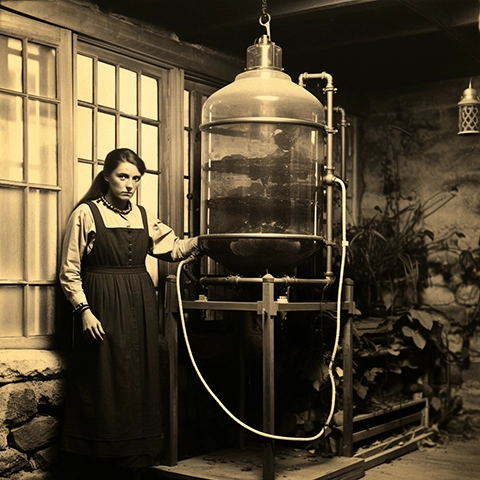In the early 1920s, amidst the backdrop of a society teetering between the remnants of war and the dawn of modernity, a peculiar narrative began to unfold in a small town. The protagonist of this story was a young alchemist named Mary Jane, whose proclivity for invention and her peculiarly fitting name would soon become etched in the cultural lexicon.
Mary Jane, with a vision to heal the emotional scars left by the Great War, embarked on a quest to construct a machine that would alleviate the sorrows of her fellow townsfolk. The result was the Moodifier, an apparatus that boasted the ability to refine and dispel the most persistent of woes. Mary Jane’s machine was a marvel of glass, metal, and mystery, its design as enigmatic as its purpose.
The test of the Moodifier’s effectiveness came in the form of Mr. Bartholomew Hargrave, a man whose reputation for gloom was as legendary as the alchemist’s ambition. In a public demonstration that drew crowds from neighboring hamlets, Hargrave was fitted with the Moodifier’s mask—a curious piece of technology that was both the conduit and the symbol of the machine’s promise.
As the townspeople watched with bated breath, Mary Jane activated the Moodifier. The machine emitted a soft hum, a prelude to the alchemical magic that was to follow. Hargrave, ever the skeptic, stood motionless, his face adorned by the mask that was now channeling the Moodifier’s mysterious vapors. Moments later, the man known for his perpetual grimace emerged with a countenance of tranquility and contentment.
The phenomenon of the Moodifier spread like wildfire, its popularity soaring as it became a staple in households far beyond the town’s borders. It was celebrated as a beacon of hope, a tool for the betterment of mankind through the mastery of technology and alchemy.
Decades passed before the secret of the Moodifier was unveiled. The device that had garnered acclaim was, unbeknownst to all, a vessel for the vaporization of cannabis. The euphoria it induced was less a product of complex emotional distillation and more a result of the ancient and natural properties of the plant itself.
The revelation came as a surprise to many but did little to diminish the fondness for Mary Jane’s invention. Instead, it added a layer of historical irony, for the name Mary Jane, once simply the moniker of an inventive young woman, became a discreet reference to cannabis itself.
The term “Mary Jane” for the herb, whispered in the speakeasies and salons of the era, became a testament to the unforeseen consequences of innovation and the enduring human desire for happiness. It was a nod to the alchemist’s legacy, a secret hidden in plain sight, a story of serendipity where a machine designed to engineer joy inadvertently christened the very substance that was its true source of wonder. Mary Jane and her Moodifier, thus, became a charming footnote in the annals of the town and the broader narrative of the Roaring Twenties.

